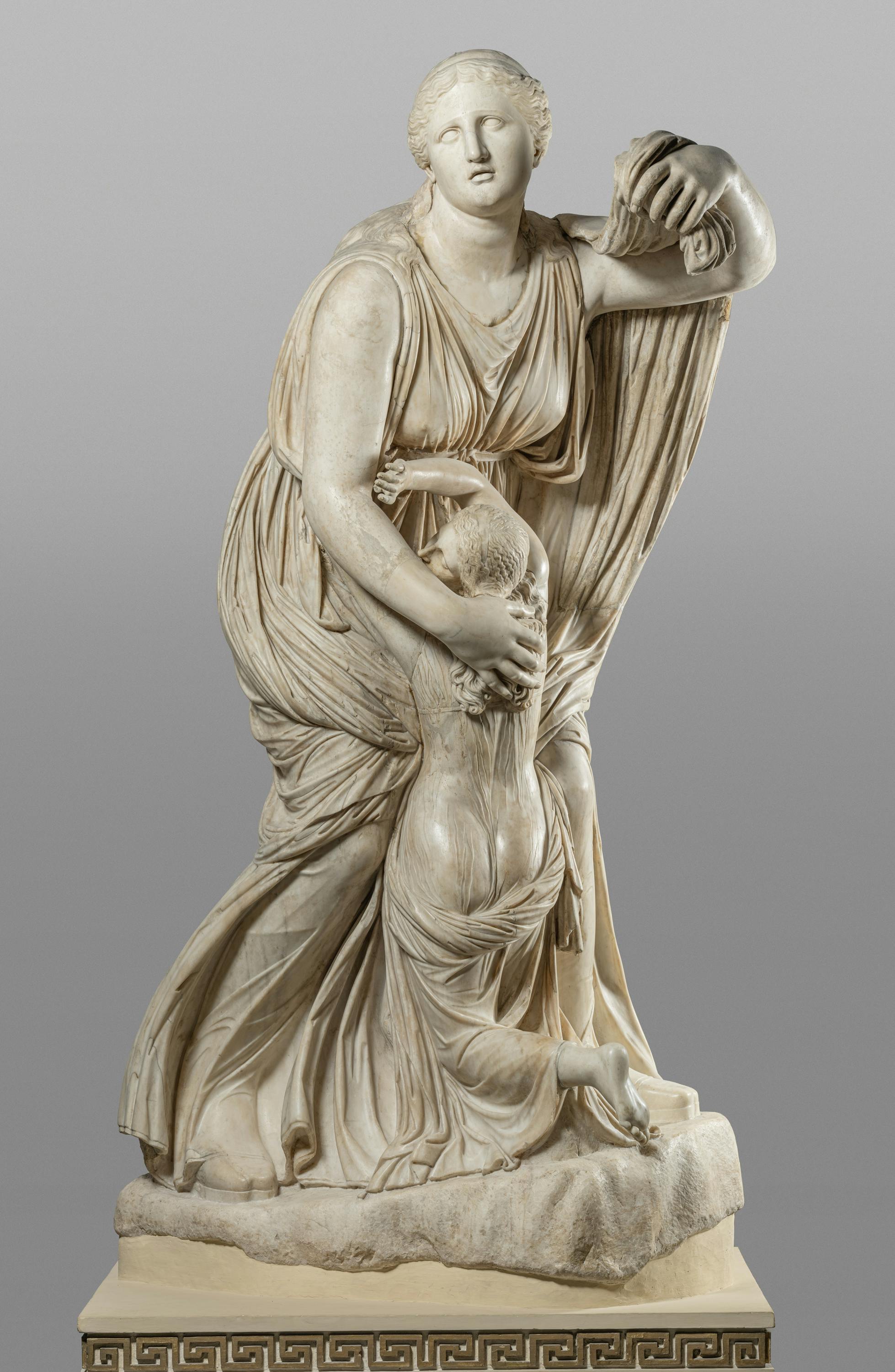Niobe with her younger daughter
Roman art
At the beginning of 1583, thirteen sculptures were found in the vineyard belonging to Gabriele and Tomaso Tommasini, located a short distance from St. John in Lateran in Rome, most of which were still in an enviable state of preservation (Nicolai 2020). The discovery, already sensational in itself considering the number of marbles found, was perceived as even more singular since almost every statue appeared to be part of a grandiose group illustrating one of the most tragic stories of ancient myth: the murder of Niobe's children. As a matter of fact, this woman, wife of Amphion, the king of Thebes, had insulted Latona, claiming that she was a better mother than her. This act of hubris (hybris in Greek) was severely punished by the goddess, who sent her sons Apollo and Artemis to kill the seven sons and seven daughters of the insolent woman. Despite being turned into a stone, Niobe, torn by grief, couldn’t stop weeping and her tears became an everlasting fountain. This connection between water and maternal figure was probably the reason behind the fortune of this group, that was considered the ideal decoration for monumental nymphaeums. It is very likely that also the Florentine Niobids, as well as the group that used to decorate the Nymphaeum-Stadium of Villa Adriana or the one of the Horti Sallustiani, were originally placed in a hemicycle fountain erected in the area of the ancient Horti Lamiani, the remains of which were brought to light in the 19th-century excavations on the Esquiline Hill in the area of today’s Piazza Vittorio Emanuele. Therefore, the Florentine group would have been part of the decoration of a nymphaeum built inside one of the vast parks owned by the emperor that encircled the Western side of the centre of Rome, and in which the statues would have been arranged following the outline of the structure, with the group of Niobe and her younger daughter placed in the centre (Diacciati 2009).
From the end of the 16th century, the Niobids were preserved in the gardens of Villa Medici on the Pincian Hill, to be then moved to Florence in 1770 at the behest of Grand Duke Peter Leopold (Cecchi-Gasparri 2009 pp. 316-318). At the Uffizi, works were started to set up a room in the Third Corridor specifically for the exhibition of the group.
After its discovery, the monumental group with Niobe trying to protect her younger daughter followed the same steps as the other sculptures of the group and in ancient times was probably the protagonist of this series of statues. The sculpture, with a weight of almost 1500 kilos, is the best-preserved replica of this powerful late Hellenistic creation. As a matter of fact, to date we have knowledge of numerous replicas of the mother's head (see, lastly, "Il mito di Niobe" 2018 p. 222, no. 21), while with respect to the two remaining figures we know only of a copy, largely mutilated, found at Villa dei Quintili on the Appian Way (Paris-Pettinau 2007) and of a smaller reproduction found in Crete (Geominy 1984 pp. 134-135). Thanks to these replicas, however, it is possible to reconstruct more accurately the position of Niobe's arms, both of which were restored in the Florentine sculpture. In fact, the mother's left arm should have been lowered, but slightly away from the body, while the right arm was resting on the daughter's arm.
W. Geominy, Die Florentiner Niobiden, Bonn 1984; M. Maugeri, L’allestimento della Sala della Niobe agli Uffizi e un ritrovato ritratto dello Zoffany, Studi di Storia dell’Arte 9 (1998), pp. 277-297; E. Diacciati, L’ambientazione originaria del gruppo dei Niobidi, in A.Natali, A. Romualdi (eds.), Il Teatro di Niobe. La rinascita agli Uffizi d’una sala regia, Firenze 2005, pp.195-205; R. Paris – B. Pettinau, Dalla scenografia alla decorazione. La statua di Niobe nella Villa dei Quintili sulla Via Appia, Mitteilungen des Deutschen Archäologischen Instituts, 113, 2007, pp. 471-483; Il mito di Niobe, catalogo della mostra a cura di A. Bruciati – M. Angles, Verona 2018; F. Nicolai, The 1584 purchase contract for the Medici group of Niobe sculptures, in The Burlington Magazine, 162, January 2020, pp. 26-31;
